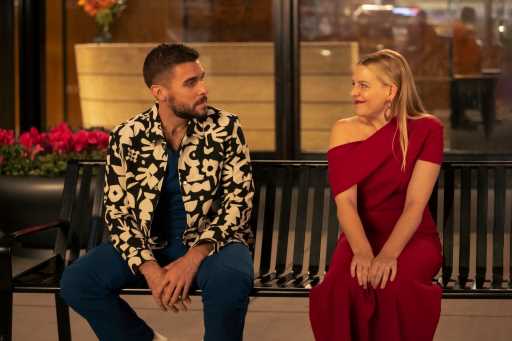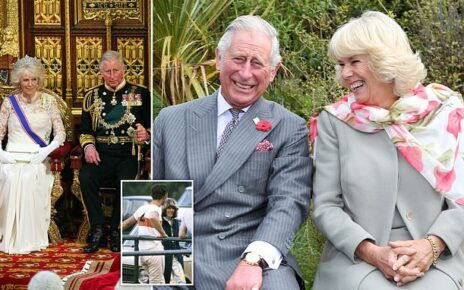SPOILER ALERT: This story contains spoilers for the series finale of “The Other Two,” titled “Brooke & Cary & Curtis & Lance,” now streaming on Max.
In the season — and now, officially, the series — finale of “The Other Two,” Brooke Dubek (Heléne Yorke) makes an analogy. After months spent chasing proof she’s a good person, Brooke is finally set to win an award for a mental health fundraiser, but she’s terrified of a backlash. “Don’t you remember when Jameela Jamil launched that body positivity app and then everyone accused her of lying about being attacked by bees?” she asks. Her assistant does not.
“The Other Two” was a show for people who do remember the minutiae of minor celebrities and the social media skirmishes surrounding them. For three seasons, the series thrived on specificity, speaking directly to viewers who understood Brooke perfectly (and could throw out a few alternate Jamil controversies for good measure) even as it acknowledged that M.O. would naturally leave some in the dark. Pivoting from Comedy Central to the service initially known as HBO Max in Season 2 seemed to offer “The Other Two” a new lease on life; linear TV was exactly the wrong place to find an extremely online audience who could appreciate an entire subplot about Instagays, while streaming was a more natural fit. But “The Other Two” is now over, its niche demo left to find another show that feels entirely comprised of inside jokes.
Creators Chris Kelly and Sarah Schneider, previously head writers on “Saturday Night Live,” have said they “always knew” the show would end at this point. Despite some mid-credits teasers that hint at a potential future, the events of “Brooke & Cary & Curtis & Lance” do, in practice, serve as a note-perfect coda to the Dubek family saga. It’s natural to lump the demise of “The Other Two” in with the many other casualties at its parent company Warner Bros. Discovery, most recently including substantial cuts to TCM. Whether or not its conclusion was planned, though, the show is ending at exactly the right time.
That may be true in several senses of the term. According to the Hollywood Reporter, Kelly and Schneider were the subject of both formal HR complaints and an informal whisper network alleging behind-the-scenes misconduct. That a sharp dissection of the entertainment industry’s amorality could turn out to be a textbook example of it is the sort of irony “The Other Two” could make a meal of; the finale itself features two Dubeks, mogul Pat (Molly Shannon) and singer Chase (Case Walker), facing a precisely rendered media backlash for their own behavior. Now, it seems the show’s ability to skewer its subjects may have come not from an observational remove, but firsthand experience — a combination of self-awareness and lack thereof all too common in show business. At least for the moment, “The Other Two” can stand as its own achievement, the product of a cast, crew and writers’ room who deserve credit in addition to, and possibly apart from, the showrunners.
Yet even the story of “The Other Two” had been trending toward a darkness that’s both difficult and undesirable to sustain. The show’s title came from the gap between Chase’s, and then Pat’s, success compared to the malaise Brooke and her brother Cary (Drew Tarver), two aimless strivers. But as the siblings found their respective grooves in talent management and acting, it only worsened their need for validation. Cary alienated his best friend with relentless narcissism; Brooke broke into her ex-fiancée’s apartment to try to prove he wasn’t the better person. The show never lost its comic fastball: Cary wore Billy Porter drag to promote his voice work as a gay blob, while Brooke engineered Chase’s bad boy rebrand complete with face tattoos. But “The Other Two” was never “Barry,” a show that could feasibly transform from a sitcom into a pitch-black drama while staying recognizably itself.
Instead, “The Other Two” had the Dubeks catch their brass ring, then watch it crumble to dust in their hands. In the finale, Cary finally gets a dose of perspective from seeing his agent care for her dying mother, an indirect echo of his father dying a year before the events of the show. He makes partial amends with his best friend, then has the wherewithal to turn down an Oscar-bait movie with Harry Styles. For her part, Brooke sacrifices her hard-won public image as a capital-g Good Person to actually do something good: take the fall for Pat and Chase, thereby saving their careers. After a final season spent exploring the hollow victories of wealth and fame, “The Other Two” let its title characters have some measure of redemption and with it, inner peace.
Happiness is about as antithetical to comedy as the nihilism “The Other Two” increasingly flirted with in its final episodes. Having the Dubeks acknowledge what actually matters thus feels like an ideal endnote, neither saccharine nor open-ended (barring Brooke’s postscript). Besides, “The Other Two” had already stretched itself to an extreme: this season alone, Pat had a sex marathon with Simu Liu on a private jet, Cary face-planted into a diaper, and Brooke went to space — twice. Fans of “The Other Two” will miss its total commitment to parodies like a “Pleasantville” riff and fluency in a particular language of the pop culture internet. But they can also say goodbye knowing the show told a complete story about bottomless need, absurd antics and the importance of genuine relationships. “The Other Two” was cynical, an outlook that helped win its loyal audience, yet secretly sentimental. Its finale was true to both.
Read More About:
Source: Read Full Article



